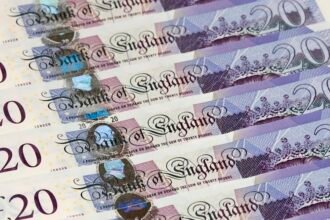- GBP/USD moves sideways near 1.2600 in the European session on Monday.
- The near-term technical outlook suggests that the bullish bias stays intact.
- Key macroeconomic data releases from the UK could drive Pound Sterling’s valuation later in the week.
GBP/USD stays in a consolidation phase near 1.2600 after gaining 1.5% in the previous week. The pair could have a hard time finding direction in the short term, with investors opting to wait for key macroeconomic data releases from the UK.
British Pound PRICE This week
The table below shows the percentage change of British Pound (GBP) against listed major currencies this week. British Pound was the strongest against the Swiss Franc.
| USD | EUR | GBP | JPY | CAD | AUD | NZD | CHF | |
|---|---|---|---|---|---|---|---|---|
| USD | 0.09% | -0.07% | -0.35% | 0.08% | -0.22% | -0.23% | 0.14% | |
| EUR | -0.09% | -0.01% | -0.46% | 0.09% | -0.23% | -0.22% | 0.15% | |
| GBP | 0.07% | 0.01% | -0.36% | 0.10% | -0.16% | -0.21% | 0.15% | |
| JPY | 0.35% | 0.46% | 0.36% | 0.42% | 0.15% | 0.32% | 0.45% | |
| CAD | -0.08% | -0.09% | -0.10% | -0.42% | -0.28% | -0.31% | 0.05% | |
| AUD | 0.22% | 0.23% | 0.16% | -0.15% | 0.28% | 0.00% | 0.37% | |
| NZD | 0.23% | 0.22% | 0.21% | -0.32% | 0.31% | -0.00% | 0.36% | |
| CHF | -0.14% | -0.15% | -0.15% | -0.45% | -0.05% | -0.37% | -0.36% |
The heat map shows percentage changes of major currencies against each other. The base currency is picked from the left column, while the quote currency is picked from the top row. For example, if you pick the British Pound from the left column and move along the horizontal line to the US Dollar, the percentage change displayed in the box will represent GBP (base)/USD (quote).
The risk-positive market atmosphere caused the US Dollar (USD) to weaken against its major rivals last week. Easing fears over US President Donald Trump’s tariff policy triggering trade wars allowed risk flows to dominate the market action. Reflecting the broad-based selling pressure surrounding the USD, the USD Index fell more than 1% on a weekly basis.
On Monday, financial markets in the US will remain closed in observance of the Presidents’ Day holiday. Hence, thin trading conditions could limit GBP/USD’s volatility in the second half of the day.
The UK’s Office for National Statistics (ONS) will publish employment and inflation data on Tuesday and Wednesday, respectively. Meanwhile, Bank of England Governor Andrew Bailey said on Monday that the impact of US trade tariffs on inflation is much more ambiguous than their impact on growth if they lead to fragmentation of the world economy. “We still see the gradual disinflation going on,” Bailey added. These comments, however, failed to trigger a noticeable market reaction.
GBP/USD Technical Analysis
The technical outlook suggests that GBP/USD remains bullish in the short term, with the Relative Strength Index (RSI) indicator on the 4-hour chart holding comfortably above 60.
On the upside, 1.2600 (round level) aligns as interim resistance. Once GBP/USD confirms that level as support, 1.2650 (Fibonacci 78.6% retracement of the latest downtrend) could be seen as next resistance before 1.2700-1.2710 (round level, static level).
Looking south, first support could be spotted at 1.2530 (Fibonacci 61.8% retracement) before 1.2500 (round level, static level) and 1.2450 (100-period Simple Moving Average).
Pound Sterling FAQs
The Pound Sterling (GBP) is the oldest currency in the world (886 AD) and the official currency of the United Kingdom. It is the fourth most traded unit for foreign exchange (FX) in the world, accounting for 12% of all transactions, averaging $630 billion a day, according to 2022 data. Its key trading pairs are GBP/USD, also known as ‘Cable’, which accounts for 11% of FX, GBP/JPY, or the ‘Dragon’ as it is known by traders (3%), and EUR/GBP (2%). The Pound Sterling is issued by the Bank of England (BoE).
The single most important factor influencing the value of the Pound Sterling is monetary policy decided by the Bank of England. The BoE bases its decisions on whether it has achieved its primary goal of “price stability” – a steady inflation rate of around 2%. Its primary tool for achieving this is the adjustment of interest rates. When inflation is too high, the BoE will try to rein it in by raising interest rates, making it more expensive for people and businesses to access credit. This is generally positive for GBP, as higher interest rates make the UK a more attractive place for global investors to park their money. When inflation falls too low it is a sign economic growth is slowing. In this scenario, the BoE will consider lowering interest rates to cheapen credit so businesses will borrow more to invest in growth-generating projects.
Data releases gauge the health of the economy and can impact the value of the Pound Sterling. Indicators such as GDP, Manufacturing and Services PMIs, and employment can all influence the direction of the GBP. A strong economy is good for Sterling. Not only does it attract more foreign investment but it may encourage the BoE to put up interest rates, which will directly strengthen GBP. Otherwise, if economic data is weak, the Pound Sterling is likely to fall.
Another significant data release for the Pound Sterling is the Trade Balance. This indicator measures the difference between what a country earns from its exports and what it spends on imports over a given period. If a country produces highly sought-after exports, its currency will benefit purely from the extra demand created from foreign buyers seeking to purchase these goods. Therefore, a positive net Trade Balance strengthens a currency and vice versa for a negative balance.






















